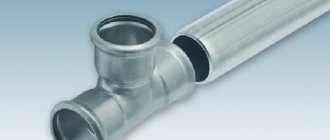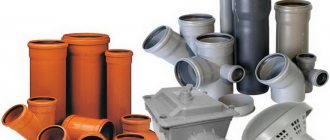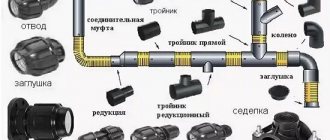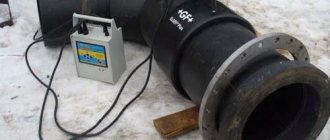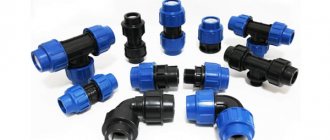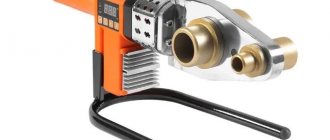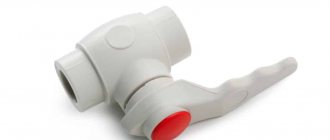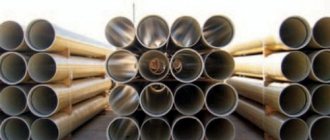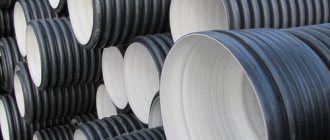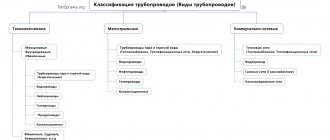Currently, polyethylene pipes are used both for repairs and for the construction of a wide variety of water supply networks, and during the design process it is imperative to make a reliable connection of polyethylene pipes. Such pipes have a number of quite significant advantages:
- long service life;
- acceptable price category;
- ease of installation.
This is what makes them so popular. Today it is known how to solder polyethylene pipes, as well as several other options for connecting polyethylene pipes. All of them will be discussed in this article.
Methods for connecting PE pipes
Characteristics of polyethylene pipes
The main characteristics of this material can be considered its main advantages:
- Pipes are able to maintain their integrity at temperatures ranging from -60 ℃ to 90 ℃. The most acceptable temperature range for normal operation is from 0 ℃ to 40 ℃.
- The production offers a wide range of polyethylene pipe sections - from 10 mm to 1600 mm. Thin pipes with a diameter of up to 160 mm are delivered to points of sale rolled into coils or coils. The length of the pipe in such a coil reaches 500 m. If the diameters of HDPE are more than 160 mm, then for sale they are cut into pieces of measured length in accordance with GOST.
- Polyethylene pressure pipes are capable of operating effectively at a constant pressure of up to 20 atmospheres.
- Polyethylene pipes are resistant to aggressive environments - acids, alkalis, and alcohol-containing substances.
- Corrosion does not occur in such pipelines.
- Thanks to the absolutely smooth inner surface, any liquid flows freely through the pipes without encountering obstacles.
In general, black pipes for water supply of this class are characterized by a long service life - 50 years or more, which is achieved due to their resistance to aggressive external influences.
However, during the production of HDPE pipes, each grade and type is necessarily tested for compliance with the declared characteristics: resistance to changes and high temperatures, tensile strength, increase in operating pressure.
How to connect a plastic pipe with a metal one in a sewer
Above, we discussed the method of connecting pipes in water supply lines and heating networks under pressure. Unlike pressure communications, domestic sewerage operates in a non-pressure mode, that is, the pipeline joints are not subject to physical impact from the working fluid transported through it. Therefore, the main requirement for joints in a sewer pipeline is to ensure tightness.
Rice. 11 Examples of how to connect a plastic pipe to a metal pipe using cuffs
Sewerage is usually laid with pipes made of cast iron and PVC polyvinyl chloride; if it is necessary to connect them, the following options are used:
Connection via cuff. If a cast iron sewer has an expanding socket at the end, a PVC pipe is inserted into it, sealing the joint with a rubber cuff. Cast iron is joined in the same way with larger PVC pipes, simply inserting them into the latter and sealing the cracks with O-rings.
Clamps. You can connect a plastic sewer pipe to a cast iron pipe using overhead clamps of a suitable size, purchased from a retail chain, or made independently.
To make clamps with your own hands, cut out a sheet of rubber, wrap it around the junction of two pipes and clamp it with clamps cut from strips of tin using bolts and nuts. If you don’t have the time or desire, you can simply wrap the joint with wire, twisting its ends tightly.
Adapters. One of the methods for connecting a PVC pipe to a metal one is to use adapters in the form of corrugated pipes with cuffs. Also, for joining pipes of different sizes, plastic shaped products are produced with a transition from large to small diameters.
Connecting couplings. You can join two pipes made of cast iron and polyvinyl chloride using a transition coupling cut from a piece of tin or PVC pipe. It is placed on top in place of the joined elements, and the resulting cracks are foamed with polyurethane foam or filled with waterproof elastic gaskets.
Rice. 12 Interfacing cast iron and PVC pipes with adapters
Parameters of HDPE products
The main factors when choosing the scope of application, as well as the method of connecting polyethylene pipes, are the wall thickness and cross-section. The relationship between these parameters and strength indicators are indicated on products with the SDR marking.
The limits of the maximum permissible operating pressure for HDPE pipes with a wall thickness in the range of 2-60 mm and a cross-section of 10-1600 mm can be found in the table. It will help you choose the right polyethylene pipes based on the individual characteristics of the system.
The method of connecting PE pipes in each specific case depends on the final purpose of the pipeline. There are two methods for working with such products. In addition, the features of this material require the use of special methods of working with them, different from the usual steel or cast iron pipes.
Couplings
The simplest type of connection. They are most often used during pipeline assembly. Connecting fittings allow you to quickly connect line elements without using tools.
Advantages:
- provide reliable fastening and durability of the connection;
- insensitive to temperature changes and mechanical stress;
- low cost;
- wide range of uses.
In terms of their operating principle and design, connection fittings are similar to compression fittings, but they are simpler and can only be used for pipes of the same diameter.
Installation of elements using couplings:
- the polyethylene pipe is inserted into a special plastic sleeve and fixed there;
- then the cover nut must be pressed by turning it clockwise.
Permanent docking
When deciding how to connect a polyethylene pipe, people tend to use this method in cases where the future pipeline is not supposed to be subsequently disassembled or moved. When performing the work, you will need a special welding machine for PP pipes. On it, the pipes are heated and joined end-to-end.
However, not every owner can afford to purchase a welding machine, especially if it is no longer useful in the future, so there is no point in overpaying. In such cases, some craftsmen have learned to use electrofusion welding. With this approach, after heating the end parts of the pipes to the melting temperature, their material is mixed, resulting in a completely durable and airtight seam.
It is worth noting that to connect pipes of this type, special electric couplings are required, the cost of which is very high. This is perhaps the main drawback of this technique. So, in cases where you need to complete a fairly large area of work with a minimal investment of funds, resistance welding will still be the best option.
Rules for working with cross-linked polyethylene
When laying a heated floor made of cross-linked polyethylene, it is important to firmly fix all bends with special clips on the dowels, since the material will try to return to its original state, especially at small bending angles. By following the rules for working with the material at the installation stage, you can avoid problems when using heated floors in the future:
- Due to the elasticity of the material, cross-linked polyethylene requires reliable fastening. The best installation for such pipes is special (there are even decorative) gutters. If single clips are used for fastening, they must be installed: on straight sections at least 1 meter apart, at joints, for rigid fixation of bends at a minimum of 3 points.
- When installing a heated floor on a cement screed, additional insulation for pipes is installed.
- When installing cold water supply communications, additional thermal insulation is required. This is necessary to prevent condensation from forming on the pipeline.
- The basis for high-quality installation is a smooth cut when preparing pipes. It is important that the cut is at an angle of 90 degrees to the guide axis. Burrs, waves, and uneven cuts will cause leaks in the future. To cut pipe material, it is not recommended to use a hacksaw - only a pipe cutter.
Note! For a one-time installation, you can purchase an inexpensive pipe cutter or rent a professional tool.
Plug-in connection
You can use the detachable connection method. In this case, there is no need to use welding, which makes it possible to dismantle the pipeline if necessary, without resorting to cutting its individual elements.
There are the following types of detachable connections:
- flanged or fitting - you will need fasteners of a special design;
- bell-shaped - elastic seals will be required.
When using one of these methods, you do not need any special equipment or tools. Regarding HDPE pipes, with a fitting connection, it will be enough to acquire an ordinary wrench. It will be possible to easily both tighten and unscrew the existing clamping parts.
Recommendations
Try to solder less by weight.
Without experience, in order to understand how to properly solder pipes, you can make several training connections. It is convenient to work with short connections by placing the welding machine on the table; in this position, you can do all possible work, and joining a partially laid line is more difficult. The soldering iron nozzle is put on a fixed polypropylene pipe, and a tee is inserted into the second part, while the device is supported by weight. When making a highway, you need to monitor the order of the connections being made. Try to avoid joining in hard-to-reach places where it will be difficult to use a soldering iron.
It is important to keep the material clean and dry, because dirt and moisture reduce the quality of the pipe connection. Even a small amount of moisture deforms the material when heated.
The chemical composition of pipes from different manufacturers may not be the same, this will lead to leaky joints. It is necessary to buy all the material - pipes and fittings - from one manufacturer.
Connecting pipes using resistance (butt) welding
This method can be considered one of the most commonly used for connecting low-pressure polyethylene pipes. The technology involves securing products to be welded in special clamps. Such clamps are installed on common guides. After this, the trimming process is carried out using certain saws.
Next, after the ends are processed, they are heated using an electric heater. This process continues until the polyethylene acquires sufficient viscosity so that it can be easily compressed using a hydraulic device. The connection of the molten mass with each other ensures a high-quality and hermetically sealed joining of HDPE pipes at the molecular level.
Thanks to resistance welding, it is possible to maintain the high flexibility of pipes without compromising the strength characteristics. And the category of equipment used determines the quality of the future connection. The highest quality finished connection will be ensured by a welding machine that will have the most capabilities, that is, it will be able to better control the heating and handling of polyethylene.
To correctly connect HDPE pipes, you should use the following instructions:
- Check that all pipes are the correct shape. For the best fit of the joints after cutting, clean them and trim them.
- Correctly place the pipes in the welding machine so that the joints are clearly opposite each other, that is, center the parts on the same axis.
- Move the heater so that it is located between the edges, then turn on the device by pressing the corresponding button. After some time, the ends of the pipes will begin to melt a little.
- Remove the heating element, then join the ends together with a little force. Keep them in this position until the material completely hardens. This process will be accompanied by squeezing out a small amount of molten polyethylene at the junction of the pipes. As a result, we will get a weld.
Devices for this joining method are of hydraulic and mechanical types. The first option refers to professional equipment, which will require the operator to have some skills in working with it.
Moreover, operating such a device requires certain qualifications, since all work must be carried out quickly, with maximum accuracy, strictly following all technological rules.
Features of installation of threaded fittings
Thanks to various types of threaded fittings when installing a pipeline, the ability to perform the most complex bends and turns is achieved.
The most common method of connecting metal/plastic structures is an “American” fitting. Such an element, which has a coupling and thread at the ends, allows you to easily and quickly join dissimilar parts
The most popular device for joining polymer and metal elements is the “American” fitting, which is available in various sizes. A convenient device with a plastic coupling and metal thread is extremely easy to install and allows you to create a reliable sealed connection in a short time.
Step-by-step installation instructions
To connect a metal pipe with a polypropylene or other plastic pipe, you must:
Using a special soldering iron, weld the fitting sleeve to the end of the polymer pipe, then wait for the joint to cool. Bring the metal part to the other end of the “American” and then tighten the thread. To seal the joint, it is advisable to additionally wrap it along the thread with one or two layers of FUM tape, tow or flax fiber (additionally, it can be coated with silicone). The fitting must always be tightened by hand: the use of tools is undesirable and even dangerous
Special equipment does not make it possible to fully control the applied forces, which can lead to damage to the part. After completing the work, it is important to check the strength of the resulting fastening. To do this, just turn on the water and make sure there is no leakage
If moisture still filters through the joint, you can try tightening the bolt a little tighter. If water continues to flow, it is necessary to unscrew the thread again and carry out all the manipulations again.
The shape of the finished connection can be changed by softening the plastic part using a hair dryer and then making the bend required by the project.
Saddles and their scope
In addition to fittings, there is another interesting device that allows you to make branches from a ready-made pipeline. These saddles are specially designed couplings. This coupling has one or more threaded holes. A tap is usually installed in them, and a new branch of the water supply is connected to it.
Saddles for polyethylene water pipes
The sedeks are put on the pipe and secured with screws. After that, a hole is drilled in the pipe surface with a drill and a thick drill in the branch. When it is ready, a crane is installed and the branch is assembled further. This is how the system is improved with minimal effort and cost.
